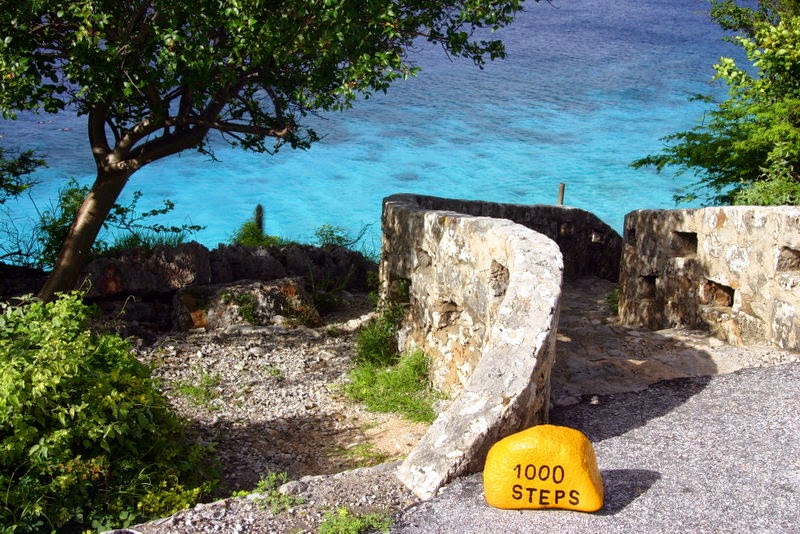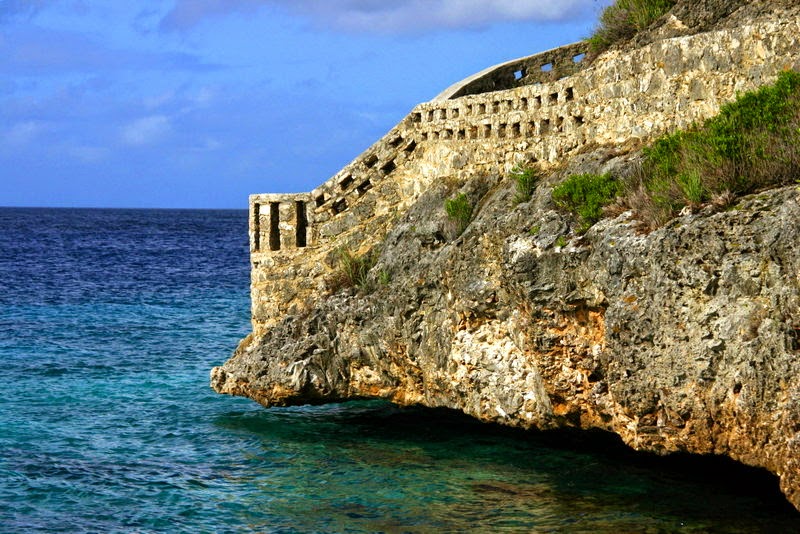I do remember the first night we were in Bonaire, I walked to the Divi Flamingo Resort (alone- I don't remember what Wayne did) here there is a small, but very accommodating, Casino. I settled in to play 3-Card Poker. The manager, Mario Arends, came over to welcome me, the stranger. We chatted & became friends. I won big time (thanks to Mario??) & obviously, had a great time. He very kindly, walked me back to the boat as it was pretty late at night. (no pictures permitted in the casino)
 | |||
| Most shops in Kralendijk are located at Kaya Grandi ('main street') where it is mostly quiet unless when cruise ships have arrived. (cruise ships no longer dock in Bonaire) |
Just an 'FYI' story. In 1995, Frank & I, our son, David, & seven other friends cruised on the Ocean Breeze from Porto Rico to the southern Caribbean. A hurricane was coming; we had to quickly leave a dinner show in PR; we then cruised to Barbados; we no sooner got there & had to leave in a big hurry. Bonaire allowed us to dock there for safety. That's how I got to see beautiful Bonaire for the first time.
We rented a pick-up truck & drove all over the island.
I'm going to mix in information from the web with my pictures.
"Bonaire is a Caribbean island which, together with Aruba and Curaçao, forms the group known as the ABC islands, located off the north coast of South America near the western part of Venezuela. Bonaire's capital is Kralendijk. The island has a permanent population of 17,408...Bonaire was part of the Netherlands Antilles until the country's dissolution on 10 October 2010, when the island became a special municipality within the country of the Netherlands."
"While Curaçao emerged as a center of the slave trade, Bonaire became a plantation of the Dutch West India Company. A small number of African slaves were put to work alongside Indians and convicts, cultivating dyewood and maize and harvesting solar salt around Blue Pan. Slave quarters, built entirely of stone and too short for a man to stand upright in, still stand in the area around Rincon and along the saltpans as a grim reminder of Bonaire's repressive past."
 |
| Slave huts |
 |
| Looking thru a slave hut |
 |
| Cargill Salt Piles |
"The island is ringed by a coral reef
which is easily accessible from the shore along the western and
southern sides. Furthermore, the entire coastline of the island has been
declared a marine sanctuary...Bonaire is also famed for its flamingo populations and its donkey
sanctuary. Flamingos are drawn to the brackish water, which harbours
the shrimp upon which they feed."
 |
| GOTO Lake |
 |
| My first time seeing Flamingos in the wild |
"Starting in the 16th century, the Dutch
raised sheep, goats, pigs, horses and donkeys on Bonaire, and the descendants of the goats and donkeys roam the island today..."
 |
| Donkeys were everywhere |
 |
| Of course, we had to stop & see for ourselves - it WAS 200 donkey steps |
"1000 Steps is one of the most renowned beaches in Bonaire, and it's also one of the island's top dive sites. The hike down to the beach is part of the reason why a 1000 Steps visit
is hard to forget. From the main road, visitors will have to negotiate
the 67 steps that lead down to the beach. There might only be 67 steps
that lead down to this beautiful beach and dive site, but it can feel
like 1000 on the way up. This is how 1000 Steps got its name."
 | |
| Ahhhhhh..... |
 | |||||
| Windjammer, Polinesia leaving port |
The triangles are separated by a white strip, inside of which are a black compass and a red six-pointed star. The blue and yellow triangles represent the sea and sun respectively while the dividing white strip represents the sky. The colors red, white, and blue also show Bonaire's loyalty to the Kingdom of the Netherlands. The black compass represents the population of Bonaire who come from the four corners of the world.
The red six-pointed star represents the original six villages of Bonaire - Antriol, Nikiboko, Nort Saliña, Playa, Rincon and Tera Korá."
Next day - Sea day - YEA!!














No comments:
Post a Comment